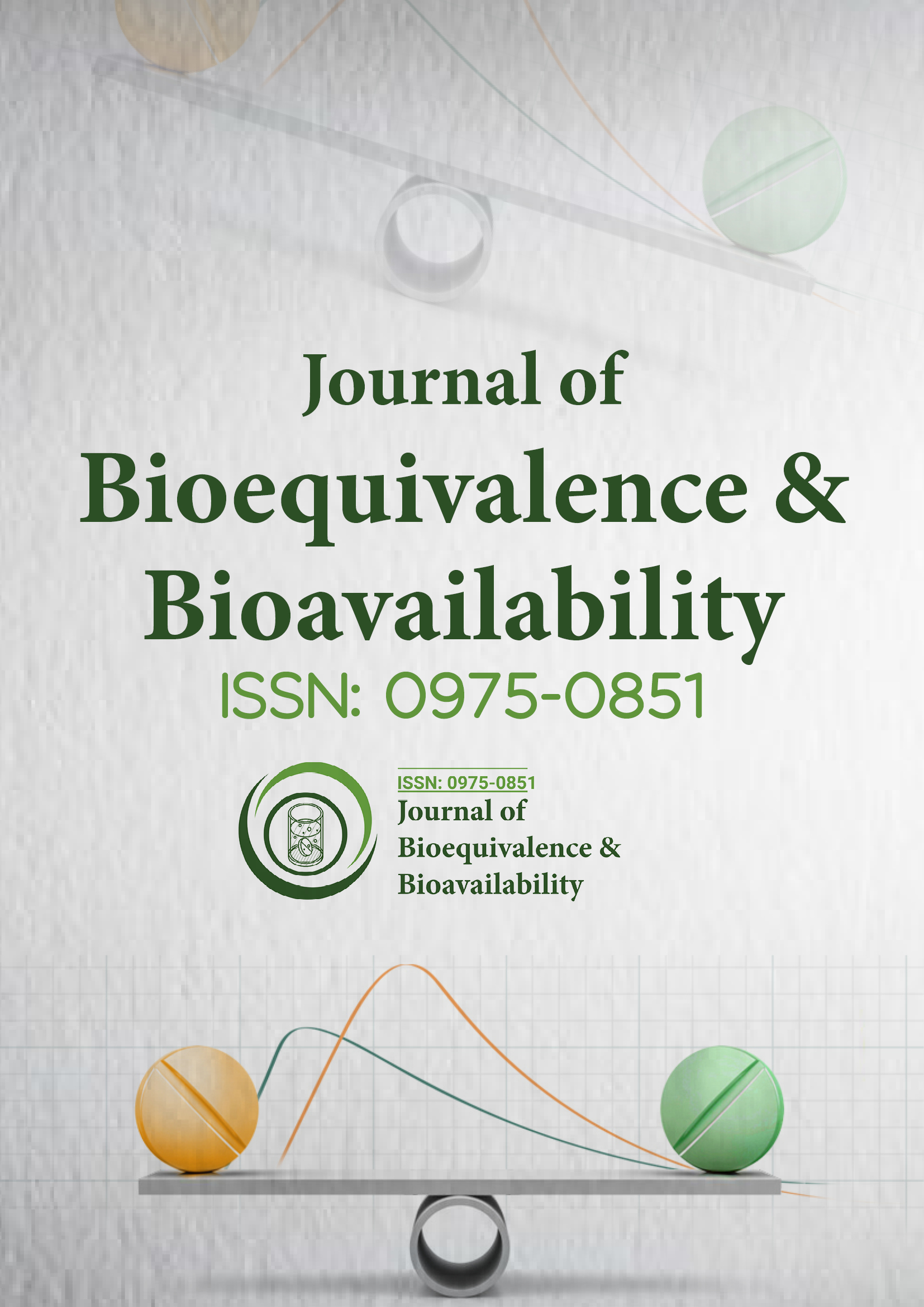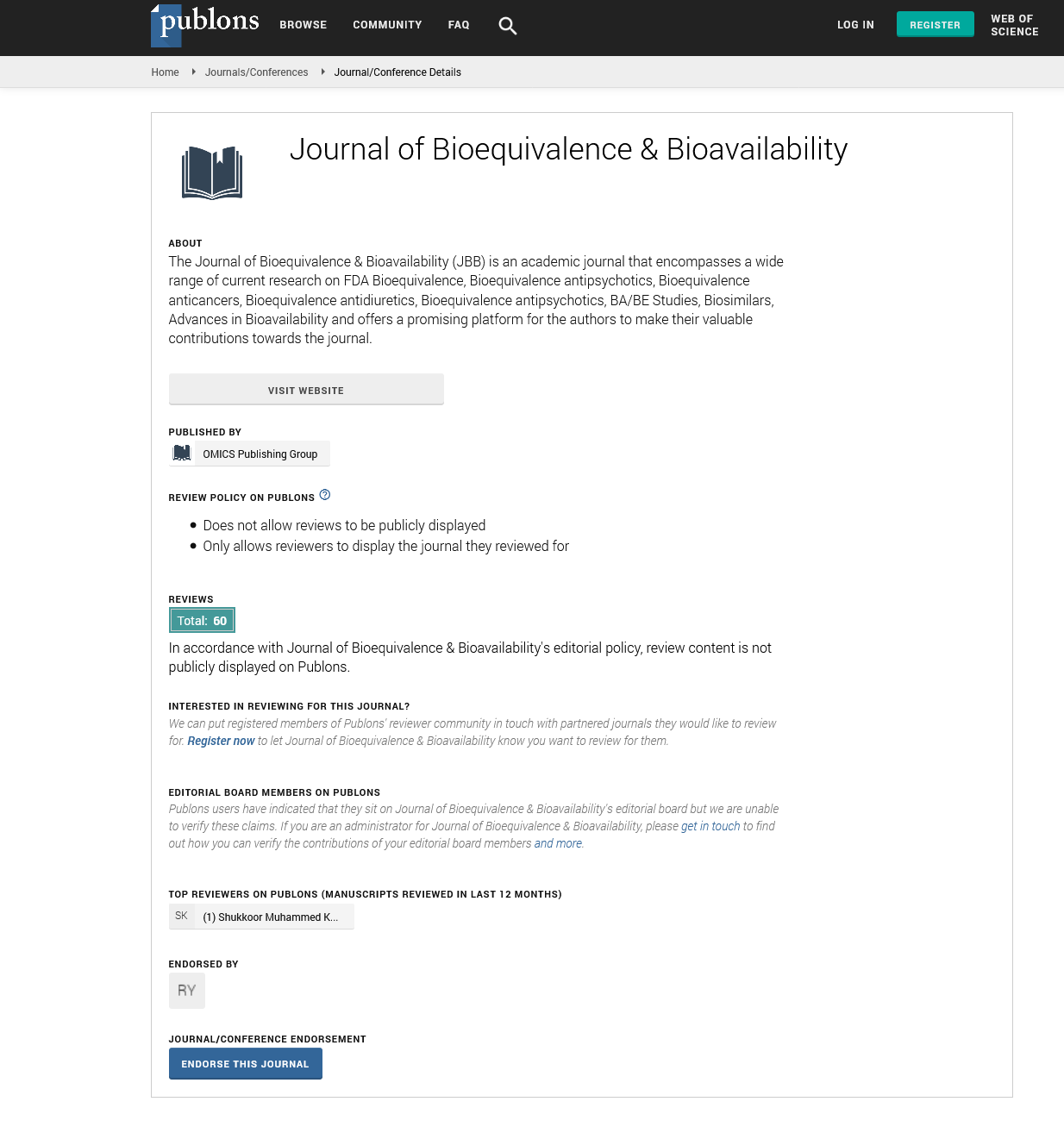Indexed In
- Academic Journals Database
- Open J Gate
- Genamics JournalSeek
- Academic Keys
- JournalTOCs
- China National Knowledge Infrastructure (CNKI)
- CiteFactor
- Scimago
- Ulrich's Periodicals Directory
- Electronic Journals Library
- RefSeek
- Hamdard University
- EBSCO A-Z
- OCLC- WorldCat
- SWB online catalog
- Virtual Library of Biology (vifabio)
- Publons
- MIAR
- University Grants Commission
- Geneva Foundation for Medical Education and Research
- Euro Pub
- Google Scholar
Useful Links
Share This Page
Journal Flyer

Open Access Journals
- Agri and Aquaculture
- Biochemistry
- Bioinformatics & Systems Biology
- Business & Management
- Chemistry
- Clinical Sciences
- Engineering
- Food & Nutrition
- General Science
- Genetics & Molecular Biology
- Immunology & Microbiology
- Medical Sciences
- Neuroscience & Psychology
- Nursing & Health Care
- Pharmaceutical Sciences
Opinion - (2025) Volume 17, Issue 1
Innovations in Clinical Trial Design to Improve Bioequivalence Assessments for Complex Generics
Qin Shen*Received: 03-Feb-2025, Manuscript No. JBB-24-28947; Editor assigned: 05-Feb-2025, Pre QC No. JBB-24-28947 (PQ); Reviewed: 18-Feb-2025, QC No. JBB-24-28947; Revised: 15-Feb-2025, Manuscript No. JBB-24-28947 (R); Published: 04-Mar-2025, DOI: 10.35248/0975-0851.25.17.624
Description
Clinical bioequivalence studies represent a critical junction where pharmacology, medicine, and regulatory science intersect to ensure that generic drug products perform comparably to their branded counterparts in real-world clinical use. As healthcare systems worldwide increasingly rely on generics to reduce costs and expand access to treatment, the integrity of clinical bioequivalence assessment becomes ever more important. While the theoretical foundation of bioequivalence is well established—predicated on the assumption that two products with similar pharmacokinetic profiles will produce comparable therapeutic outcomes—the translation of this concept into clinical practice is fraught with complexity. Clinical bioequivalence studies aim to bridge this gap by evaluating whether these pharmacokinetic similarities indeed correspond to equivalent safety and efficacy outcomes when administered to human subjects under standardized conditions.
Traditional bioequivalence studies rely heavily on Pharmacokinetic (PK) parameters such as the Area Under the concentration-time Curve (AUC) and the maximum observed concentration. These parameters serve as proxies for the rate and extent of drug absorption, under the assumption that if two products deliver the same amount of Active Pharmaceutical Ingredient (API) into the bloodstream at the same rate, their therapeutic effect should be the same. However, this approach, while scientifically grounded and statistically rigorous, can overlook subtleties inherent in drug behavior, particularly when it comes to complex dosage forms, site-specific delivery mechanisms, and patient-specific physiological factors. This is where clinical bioequivalence studies become not only relevant but essential.
One of the strengths of clinical bioequivalence studies is their ability to provide a more holistic view of therapeutic performance. These studies incorporate the variability inherent in patient populations, including genetic differences, comorbidities, and lifestyle factors, thereby offering a more realistic assessment of how a generic product will perform outside the controlled environment of a pharmacokinetic trial. However, this very complexity also presents significant challenges. Clinical endpoints are often less precise than PK parameters, requiring larger sample sizes and longer study durations to detect differences—or the lack—with statistical confidence. Moreover, clinical outcomes are more susceptible to placebo effects, observer bias, and inter-site variability, all of which must be carefully controlled through rigorous trial design and execution.
The regulatory landscape surrounding clinical bioequivalence studies varies across jurisdictions. Agencies such as the U.S. Food and Drug Administration (FDA), European Medicines Agency (EMA), and World Health Organization (WHO) recognize the necessity of clinical studies in certain situations but generally regard them as a last resort due to their cost, complexity, and potential for variability. Nonetheless, they remain indispensable for certain drug categories. For instance, in the case of Narrow Therapeutic Index (NTI) drugs, where small differences in concentration can result in loss of efficacy or increased toxicity, clinical bioequivalence data may be required in addition to PK assessments to ensure patient safety. Similarly, for drugs with complex pharmacodynamics or nonlinear dose-response relationships, clinical trials can provide critical insight into real-world performance.
Another area of growing interest is the application of clinical bioequivalence studies in the development and approval of biosimilars—biologic products that are highly similar to an already approved reference biologic. Due to the complex and often immunogenic nature of biologics, PK studies alone are rarely sufficient to establish equivalence. Clinical trials, sometimes involving immunogenicity testing, efficacy endpoints, and long-term safety data, are usually mandated. These studies not only validate the biosimilar’s performance but also reinforce public confidence in these cost-effective alternatives, which are poised to transform treatment landscapes for conditions ranging from autoimmune diseases to cancer.
While clinical bioequivalence studies offer a vital tool in the evaluation of generics and biosimilars, they are not without their critics. The primary concern lies in the trade-off between scientific rigor and logistical feasibility. Clinical trials are expensive, time-consuming, and often ethically complex, particularly when testing a generic against a well-established standard of care.
Citation: Shen Q (2025). Innovations in Clinical Trial Design to Improve Bioequivalence Assessments for Complex Generics. J Bioequiv Availab. 17:624.
Copyright: © 2025 Shen Q. This is an open-access article distributed under the terms of the Creative Commons Attribution License, which permits unrestricted use, distribution, and reproduction in any medium, provided the original author and source are credited.

